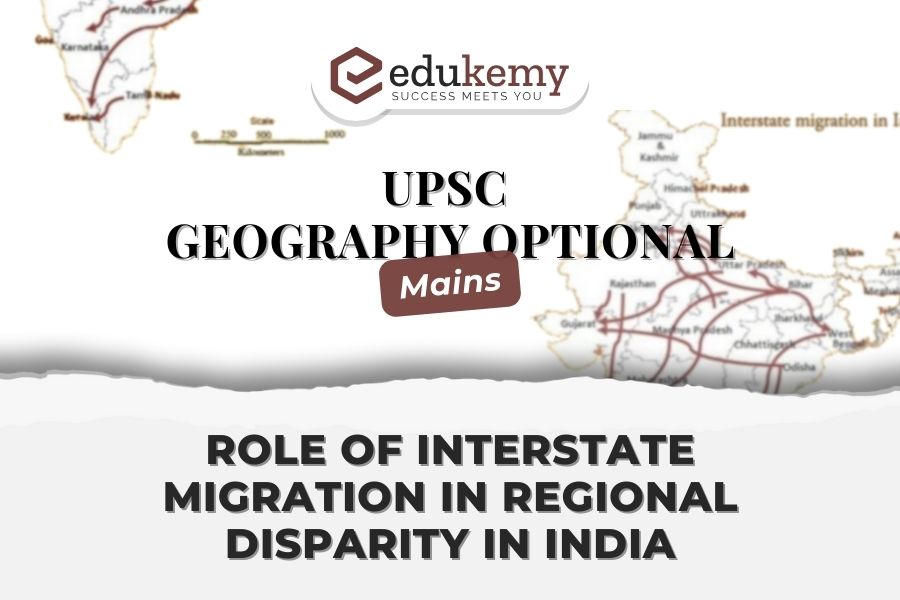
Explore the intricate dynamics of interstate migration and its impact on regional disparities in India. Delve into how the movement of people between states influences demographic patterns, labor markets, and socio-economic development. Analyze the push and pull factors driving migration, including employment opportunities, wage differentials, and social networks. Understand how migration contributes to uneven distribution of human capital, resources, and infrastructure, exacerbating disparities between regions. Examine the implications for urbanization, social cohesion, and governance, considering challenges related to housing, transportation, and service delivery. Gain insights into policy responses aimed at addressing migration-induced disparities and fostering inclusive development across India’s diverse geographical and socio-economic landscape.
Contents
Answer:
Introduction:
Interstate migration refers to the movement of people from one state to another within a country, and in India, it significantly influences regional disparities by shaping the demographic and economic landscapes of different states.
Body:

Positive role of interstate migration in regional disparity in India:
- Economic Growth: Interstate migration can contribute to the economic growth of destination states.
- For example, Mumbai’s status as a financial hub has been bolstered by the migration of skilled professionals from other states, contributing to the city’s economic dynamism.
- Labor Market Dynamics: Migrant workers play a crucial role in filling labor shortages in various sectors.
- For instance, in Punjab, migrant laborers from Uttar Pradesh and Bihar contribute significantly to the agricultural sector during harvesting seasons, ensuring timely crop cultivation and harvest.
- Cultural Exchange: Metropolitan cities like Delhi and Chennai thrive on cultural diversity brought about by migration.
- For instance, the street food culture in Delhi has been enriched by migrants from different regions, offering a wide array of culinary delights.
- Remittances: The remittances sent by migrants to their families in their home states serve as a vital source of income.
- For example, in states like Kerala and Uttar Pradesh, remittances from migrants working in the Gulf countries contribute significantly to household incomes and local economies.
- Skill Transfer: Migrants bring diverse skills and expertise to destination states, fostering innovation and technological advancements.
- For instance, the IT industry in Bengaluru has benefitted from the influx of skilled workers from other states, contributing to the city’s reputation as the Silicon Valley of India.
- Political Integration: Migration fosters political integration and national unity as people from different states interact and contribute to the socio-political fabric of the country.
- For example, political participation by migrants in local elections in states like Haryana and Gujarat reflects their integration into the political landscape.
Negative role of interstate migration in regional disparity in India:
- Strain on Infrastructure: Rapid influx of migrants strains existing infrastructure such as housing, transportation, healthcare, and sanitation in destination cities, leading to inadequate provision of services and increased congestion.
- Cities like Gurugram and Bengaluru face significant strain on infrastructure due to rapid migration, leading to overcrowded roads, inadequate housing, and insufficient public transport systems.
- Urban Sprawl: Unplanned migration contributes to the proliferation of slums and informal settlements, exacerbating urban sprawl and straining resources.
- For example, Dharavi in Mumbai has emerged as one of Asia’s largest slums due to unplanned migration and rapid urbanization.
- Exploitation of Migrant Workers: Migrant workers often face exploitation and abuse in sectors such as construction and domestic work.
- Instances of low wages, long working hours, and unsafe working conditions are prevalent, particularly in states like Tamil Nadu and Kerala.
- Social Tensions: Tensions between migrants and local communities can arise due to competition for resources and job opportunities.
- For example, in Assam, tensions have flared between indigenous communities and migrants from Bangladesh over issues of identity and resource allocation.
- Brain Drain: Migration of skilled professionals from less developed states to more developed ones can exacerbate the brain drain phenomenon.
- For example, the healthcare sector in states like Bihar and Uttar Pradesh suffers from a shortage of skilled medical professionals due to migration to metropolitan cities for better opportunities.
- Displacement of Indigenous Communities: Large-scale migration can lead to the displacement of indigenous communities and disruption of traditional livelihoods.
- For instance, the construction of infrastructure projects in tribal areas of Odisha and Jharkhand has led to the displacement of tribal communities, exacerbating socio-economic inequalities.
- Pressure on Public Services: Increased demand for public services strains resources and infrastructure.
- For example, in cities like Delhi and Bengaluru, public hospitals and schools struggle to cater to the growing population, leading to overcrowded facilities and compromised service quality.
- Environmental Degradation: Rapid urbanization driven by migration contributes to environmental degradation.
- For example, the pollution levels in cities like Kanpur and Kolkata have soared due to industrial activities and vehicular emissions, posing health hazards to residents.
Conclusion:
Addressing these challenges requires comprehensive policies focused on urban planning, skill development, social welfare, and equitable resource distribution to ensure inclusive and sustainable development across states.
In case you still have your doubts, contact us on 9811333901.
For UPSC Prelims Resources, Click here
For Daily Updates and Study Material:
Join our Telegram Channel – Edukemy for IAS
- 1. Learn through Videos – here
- 2. Be Exam Ready by Practicing Daily MCQs – here
- 3. Daily Newsletter – Get all your Current Affairs Covered – here
- 4. Mains Answer Writing Practice – here

